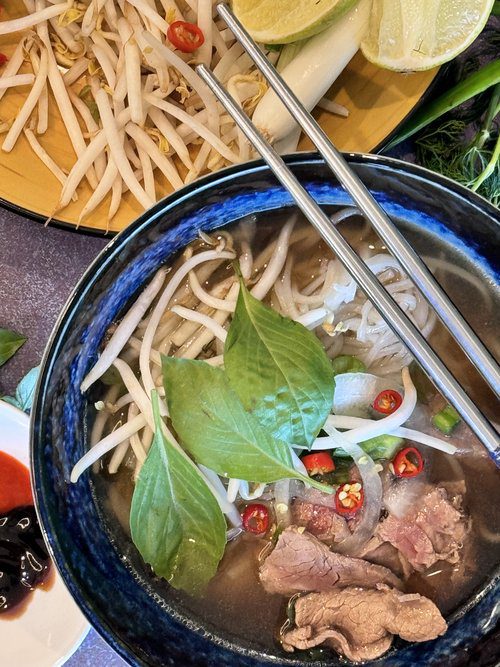Soup season is upon us, and there is nothing more comforting than slurping a bowl of pho on a cold day. Really, I think any day is a good day to eat pho, but eating it when it’s cold and blustery outside is like getting a warm hug from a loved one. This Instant Pot recipe will become your best friend.
I grew up eating pho. It was a staple for my family, as well as many Vietnamese families each weekend. There weren’t many weekends that we didn’t have pho. This Instant Pot Pho recipe is a heart-warming soup that takes a very long time to make—up to 6 hours and possibly more if you have time. That is the reason why it’s made on the weekend—something that takes so long needs to be eaten for a few days to be worth it.
It wasn’t until a few years ago that the pho craze started sweeping across the American culture. In fact, step outside your door in most major US cities, and you will find a pho restaurant. Interest in pho has risen exponentially as it moved from Vietnamese home kitchens to mainstream America. But where did Pho come from and how did it become Vietnam’s favorite soup?
THE HISTORY OF PHO
Would you be surprised if I told you pho is a relatively new food? Like any food, the answer is unclear. Legend has it that it started in a village in Nam Dinh Province located about sixty miles southeast of Hanoi. Beef wasn’t common in Vietnamese food. In fact, the Vietnamese had the cattle working the rice fields rather than eating them.
It wasn’t until the French colonized Vietnam from 1880 to 1954 that beef became widely used in cooking. The leftover bones were used and sold by the Hanoi butchers. At the time, there was a soup called xao trau, made with buffalo meat served in a broth with rice vermicelli. The buffalo was later swapped for beef, and eventually, the Hanoi pho was born.

WHAT IS PHO
Pho, pronounced “fuh” is a Vietnamese soup that is normally made with beef bones and spices simmered for hours. It’s served with rice noodles (banh pho) and garnished with a variety of herbs like Thai basil and cilantro. It’s usually garnished with chiles, bean sprouts, hoisin sauce, and lime.
INGREDIENTS
Spices
A blend of aromatic spices creates the dimension of flavor in the broth. Each spice contributes to the broth, not one overpowering the other.
Star Anise: tastes like licorice, with a lightly bitter note. The flavor is in the petals. A whole star anise has about eight seed pods.
Chinese Black Cardamon: has a smoky, woodsy, menthol taste.
Cinnamon: has a warm and earthy note and complements the star anise and cardamon. Use cinnamon sticks, not ground cinnamon.
Clove: use whole cloves, not grounded.
Coriander Seeds: has a citrusy and delicate note. Look for spherical coriander seeds as football-shaped ones are too sweet.
Fennel Seeds: this is similar to coriander and adds a hint of sweetness
These spices can be purchased separately, but I prefer to buy a Pho spice bag that contains all the spices in one bag to make my life easier. This one is my favorite.
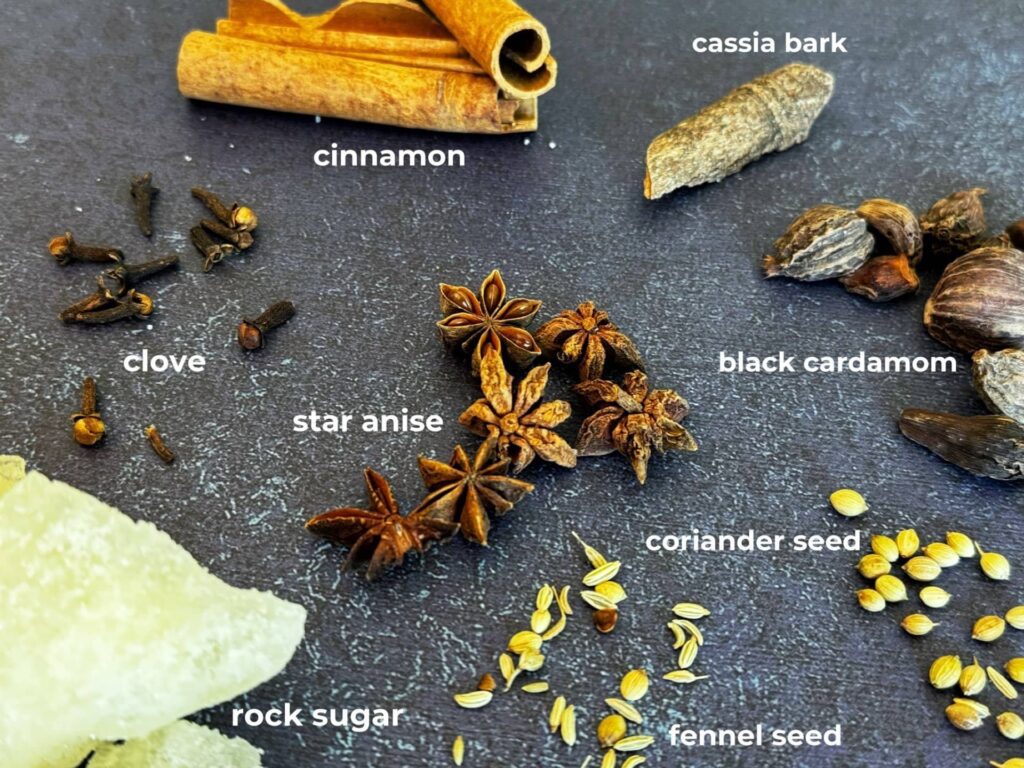
Noodles
Banh pho are flat rice noodles. They are sold in different widths, but narrow rice noodles are best for pho. It is available fresh and dried. I prefer the fresh ones found in the freezer section of most Asian supermarkets.
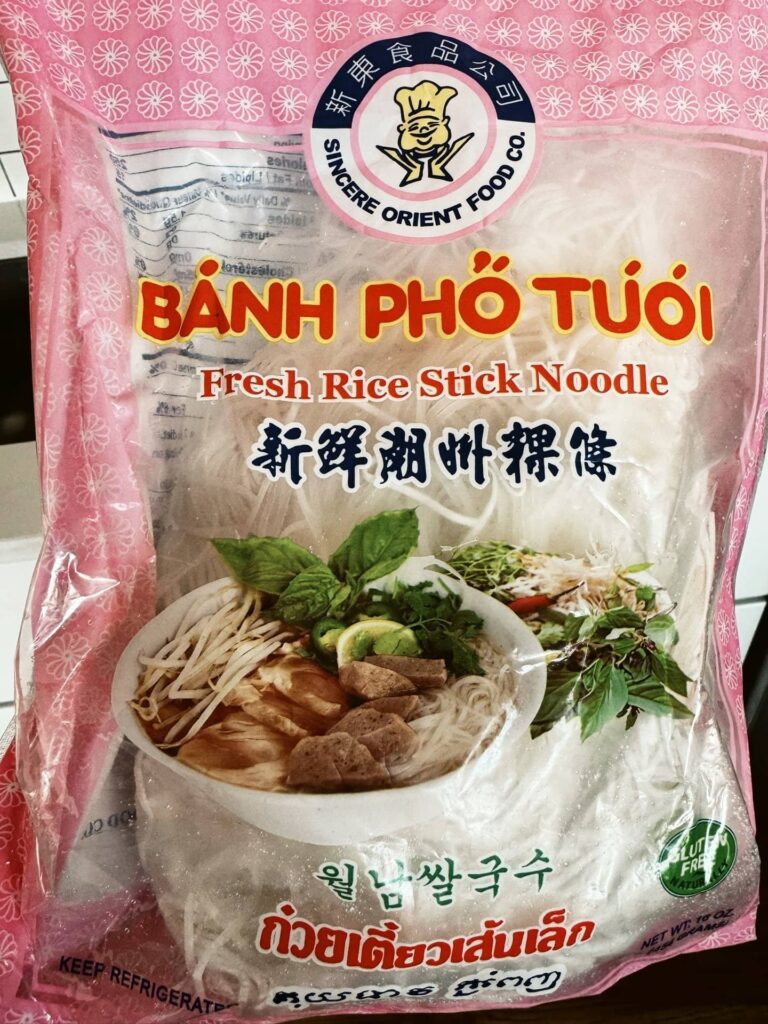
Aromatics
Ginger: provides a nice mellow flavor to the broth.
Onions: use a medium to large size whole onion. Onions are also used to garnish soup bowls.
Green Onions: used as a last-minute garnish atop the soup.

Salt
Salt produces a savory broth well known for pho. I like to use Diamond Crystal kosher salt. If using Morton’s, just know the salt content is higher so you will need less.
Sweeteners
Chinese Yellow Rock Sugar should be used as it rounds out the other flavors and brings everything together. Avoid granulated sugar and will produce a sweet, flat broth. According to my mother, using granulated sugar will make your broth cloudy as well. More to come on that.
Seasonings
Many recipes will call for adding this in the broth while it simmers, but I prefer to add it in as a condiment. Experiment with both and see what you like. Use a premium brand of fish sauce like this one from Three Crabs.
Herbs
Cilantro: this herb is used to garnish in many Vietnamese dishes and is a classic herb for pho.
Thai Basil: lends a licorice flavor to the pho. Can be purchased at many Asian markets.
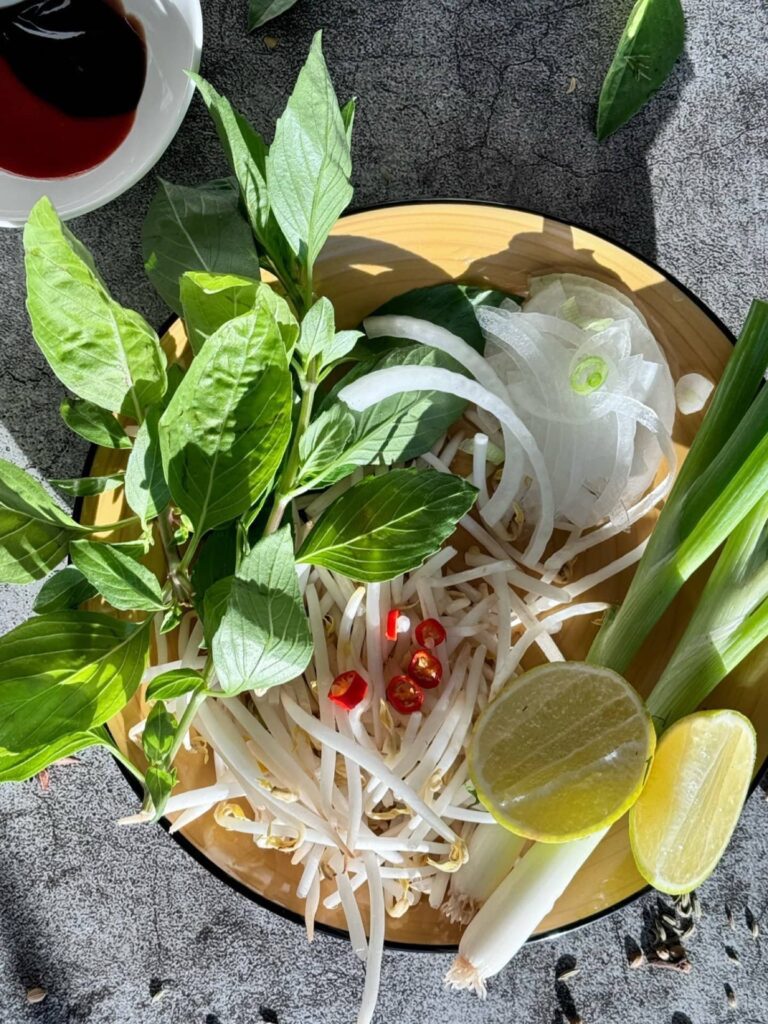
Garnishes
Bean sprouts: add a crunchy texture and balance out the soft noodles. Make sure you are buying mung bean sprouts and not soybean sprouts.
Chile: can be Thai pepper or jalapeno peppers. add a nice heat to the pho.
Hoisin Sauce: made of fermented soybean paste and adds sweetness to your pho.
THE BROTH
The broth is where the goodness and magic happen. While this recipe is not the traditional way to make pho, meaning the longer way, the broth still needs to be the main attraction. Below are some tips to ensure that your broth is full of flavor and dimensions. This Instant Pot Pho recipe will produce a very similar broth made in the traditional way.
Color and Clarity
When I first learned how to make pho from my mom, she emphasized a clear broth. She stressed that your broth’s color should look like tea color. If your broth is dark and dingy, you are doing something wrong.
Some ingredients can cause the broth to be dark, like fish sauce. Also, I find that if you add in your spice bag early, your broth will be darker. I like to add the spice bag in halfway through cooking.
Another factor that contributes to a darker broth is your heat is too high, thereby, cooking your beef bones too fast. The heat must be on a gentle boil. Parboiling your bone is also a necessity as it produces a clear broth.

Low Heat
As mentioned above, you must cook your broth at a low heat, maintaining a low simmer. Cooking it at a low simmer slowly draws out the bone marrow and goodness. This Instant Pot pho recipe while cooked at a high temperature, will reduce the cooking time, but not compromise the flavor.
Straining the Broth
After your broth is done, strain the entire pot to remove impurities. I like to place a piece of cheesecloth over the strainer to make sure I catch everything.
Beef Bones
This Instant Pot Pho recipe is a traditional pho made with beef. You can substitute for chicken if you prefer. Parboiling your protein will help remove any impurities before simmering on the stove. To do this, bring a pot of water to a boil. Add salt and add your protein.
Boil until your protein is cooked. You will notice scum and impurities floating to the surface. Just think if you didn’t parboil. This should take about 2-4 minutes. Remove from heat and rinse under cold water, scrubbing your protein as you clean. You can then return the protein to your pot and continue with the recipe. This should be your first step in making pho.
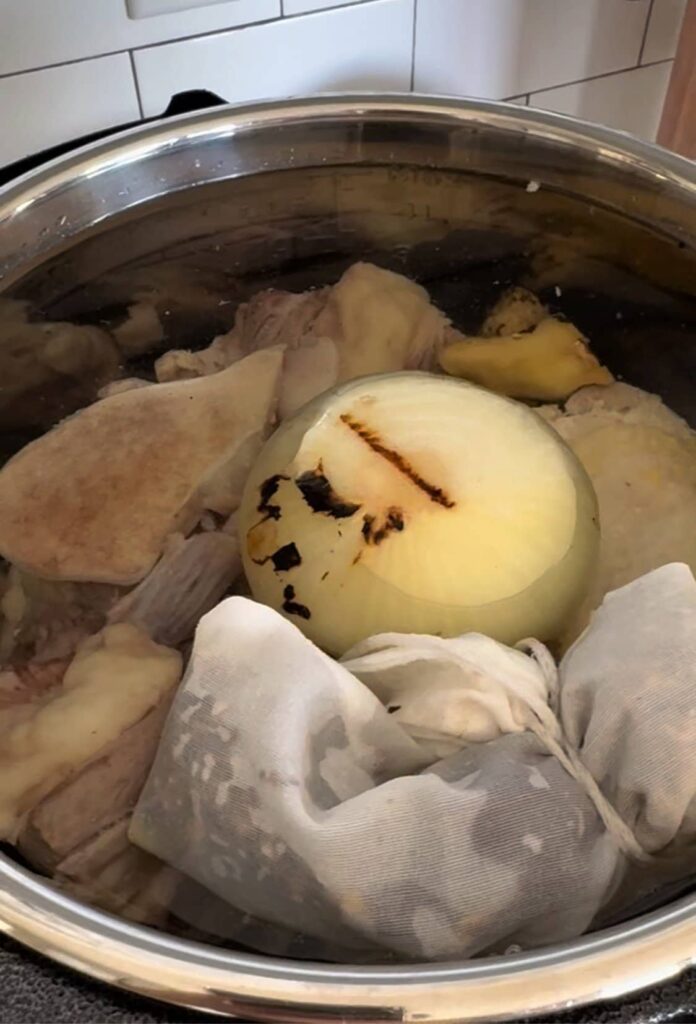
THE RECIPE
As mentioned, the traditional way to make pho takes hours to make, but with the popularity of the Instant Pot, it’s never been easier to make pho faster. This method will take about 1 1/2 hours to make but still produce good results in little time. This Instant Pot pho recipe checks all the box for the perfect bowl of pho!
Step 1: Make the Broth
You will need about 3 pounds of beef bones, preferably bones that contain marrow. I prefer to use ox tails as it lends a flavorful broth. If cooking the traditional method, I add a whole chicken as well. With this method, you can add a chicken leg quarter to add to maximize flavor.
Parboil the protein by bringing a pot of water to barely cover your beef bones to a boil. Make sure it comes to a vigorous boil, cooking for about 2-4 minutes. Remove the bones and rinse under cold running water, brushing any scum and residue off. Set aside.
Char your ginger and onion by using tongs and placing it over an open flame on your stove. You want it to be blackened lightly. Rinse away the blackened skin afterward. If you do not have a gas burner, wrap the ginger and onion in foil and roast in the oven at 375° for about 10 minutes until fragrant. Set aside.
Toast your Spice by placing it in a pan over medium heat. Toast for about several minutes, shaking until fragrant. Place your spice in a spice bag and seal. I like to use this as it comes with the spice and bag. I use half of the spice from this bag for this recipe since it’s a smaller amount. You can also do this in your Instant Pot by turning to Saute mode.
Add 9 cups of water to your Instant Pot or pressure cooker. Add your beef bones and chicken quarters if using. Add your charred onion and ginger. Add in your spice bag. Add in your rock sugar, about 20 grams. Add 2 1/4 teaspoons of sea salt. Add in 3 tablespoons of chicken bouillon.
Place the lid on your Instant Pot and turn the knob to Sealing Position. Pressure cook on high for 1 hour, with 30 minutes for natural release.
When cooking is done, remove the lid and use tongs to remove the bones from the pot. If there is any fat from the broth, skim and remove it. Some people love the fat as it makes the broth more flavorful.
Strain using a strainer with a piece of cheesecloth on top. Taste your broth and adjust if needed by adding more salt or even fish sauce and sugar. You are looking for an umami savory sweet finish with a hint of saltiness.
Step 2: Prep and Assemble your Bowls
While the broth is cooking, prepare your garnish by slicing a whole onion thinly. Slice one bunch of green onions, green parts only. Roughly chop cilantro tops and set aside. Wash your Thai Basil and any other herbs you are using.
Pour the hot broth over noodles and steak. The broth will cook the steak
For this recipe, I am using fresh pho noodles, but if you can’t find fresh ones, you can use dried ones. Cook the noodles according to the package instructions.
Slice your flank steak thinly. Pro tip: if you put your steak in the freezer and let sit for about 30 minutes, slicing it thinly will be easier. Set aside.
In your bowl, add in your cooked noodles. Place your sliced flank steak on top, followed by onions, green onions, and cilantro. Bring your broth to a simmer over medium high heat. As soon as it starts to boil, ladle the broth over your bowl. Don’t worry, the hot broth will cook the steak. Now go enjoy knowing that you didn’t spend hours in the kitchen making this!
The most perfect Instant Pot Pho Vietnamese Beef Noodle Soup
Adapted from Loretta Keller’s recipe.
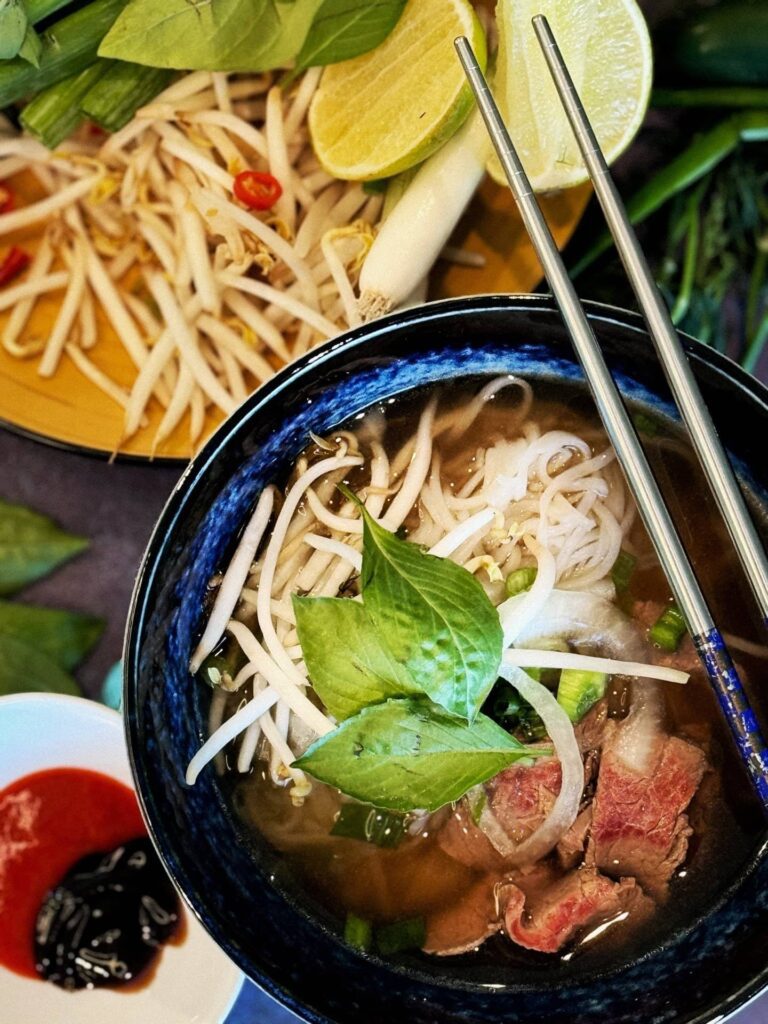
✅ Quick Tips: Read the recipe in its entirety before you start cooking. This will help you understand the ingredients, steps, and timing involved, and allow you to prepare any necessary equipment or ingredients beforehand.
